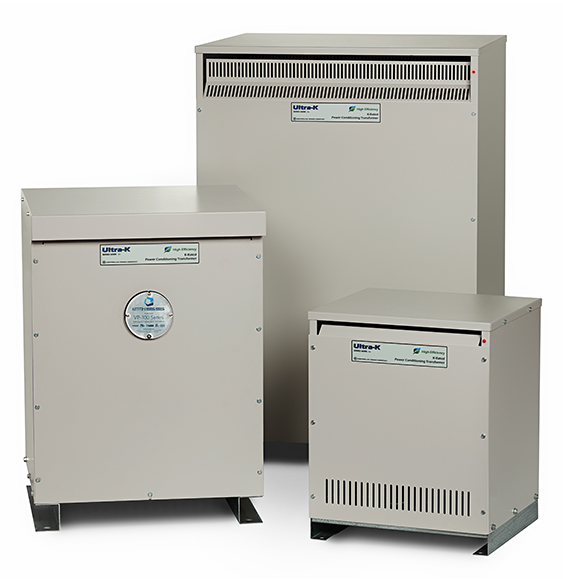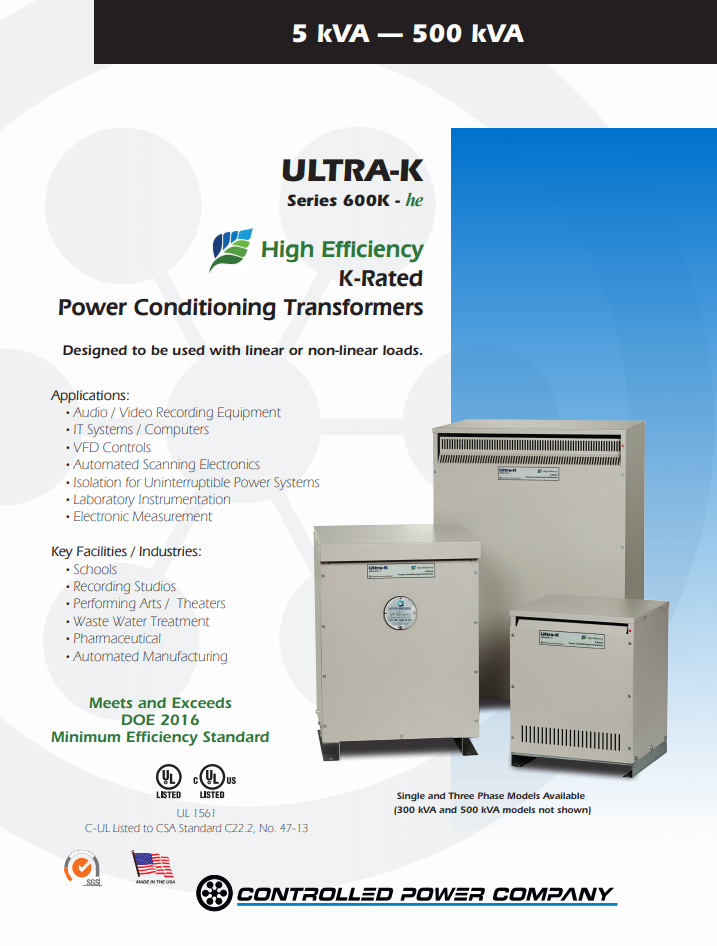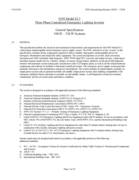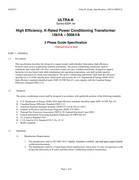ULTRA-K Series 600K-he
(15kVA - 500kVA) Three Phase
Description:
![]() High efficiency, K-rated power conditioning transformers which meet and exceed DOE 2016 minimum efficiency standards!
High efficiency, K-rated power conditioning transformers which meet and exceed DOE 2016 minimum efficiency standards!
The ULTRA-K Series 600K-he is a high efficiency, K-rated, power conditioning transformer, specifically designed to provide a high degree of electrical noise attenuation and transient voltage suppression to protect sensitive electronic loads. Offered with four different K-factor ratings (K4, K7, K13, and K20), the ULTRA-K is fully compatible with non-linear loads, handling the high harmonic currents associated with such loads.
Three phase models include nominal input voltage options from 208VAC to 600VAC (Delta). Standard output voltages are 208/120VAC or 480/277VAC. Special output voltages include 400/230VAC, 460/266VAC or 600/347VAC.
The ULTRA-K is provided in a NEMA 2 enclosure up to 225 kVA; NEMA 1 at 300kVA and 500kVA; and optional NEMA 3R up to 225kVA.
Three Phase Sizes: 15kVA, 30kVA, 45kVA, 75kVA, 112.5kVA, 150kVA, 225kVA, 300kVA, 500kVA

- Transformer power losses are lower than mandated by the DOE 2016 Standard, yielding a direct decrease in operating costs over the life of the transformer
- Double or triple shielded for high common mode noise attenuation from input to output; and also prohibits system back feed from noise generating load
- Optional output category B3 SPD (40kA per mode) with high frequency filter provides critical loads with optimum protection from noise, impulses, and high-energy voltage transients
- Optional output SPD (50 kA to 200 kA per phase), UL 1449 Listed, Type 2, including EMI/RFI filtering, Form C relay contacts, and LED status indicators
- Multiple K-factor ratings (K4, K7, K13, K20) allow proper application for both linear and non-linear loads … the higher the K-factor rating, the more harmonic current the transformer can handle
- Designed specifically to handle the harmonics, heating effects, and increased output neutral current created by non-linear loads
- Removes load-generated triplen harmonics from the incoming power source
- All-copper wound transformer construction allows the optimization of conductor size and geometry, to enhance harmonic-handling capability and transformer efficiency
- Standard, floor mounted enclosure: NEMA 2 up to 225 kVA; NEMA 1 at 300kVA and 500kVA; optional NEMA 3R outdoor enclosure available up to 225kVA
- Optional input and/or output circuit breaker(s) provided in a separate NEMA 1 enclosure for external mounting and installation
- Optional high/over temperature alarm contacts provided for tripping upstream breakers if required
- Optional industrial-grade IR scanning window(s) for safe, routine thermal scanning of transformer connections under load, without exposing personnel to arc flash hazards
- Optional lug kit available … mechanical (screw-type) lugs shipped for installer convenience
- Special voltage configurations available, including “high leg delta” designs
- Efficiency: U.S. — Meets and exceeds U.S. Department of Energy (DOE) 2016 minimum efficiency standards identified under DOE 10 CFR Part 431
- Canada — Meets and exceeds CSA Standard C802.2-12
- Multiple Voltage Compensation Taps: Full capacity above/below nominal
- Output Impedance: 2% – 3.5% typical
- Output Distortion: Less than 1.0% THD added under linear load
- Load Regulation: 2% typical, no load to full load
- Overload: Up to 500% for 10 seconds, 1000% for 1 cycle
- Isolated Neutral: Establishes a new neutral to ground bond on the transformer’s output
- Common Mode Noise Attenuation: 126 dB (standard double shielding); 146 dB (optional triple shielding)
- Transverse Mode Noise Attenuation: 3 dB down at 10kHz, decaying 20 dB per decade; decaying 40 dB with “SPD With High Frequency Filter” option
- Operating Temperature: -25°C to +40°C
- Audible Noise: 45 to 55 dBA @ 1 meter (kVA size dependent)
- Neutral Size: Twice the ampacity of the secondary phase conductor on the three phase models
- Temperature Rise: 135°C rise above ambient, under non-linear loading per UL 1561 standard
- UL 1561 Listed, labeled for operation at or below a specific K-factor rating
- C-UL Listed to CSA Standard C22.2, No 47-13
- Audio/Video Recording Equipment
- IT Systems/Computers
- VFD Controls
- Automated Scanning Electronics
- Isolation For Uninterruptible Power Systems
- Laboratory Instrumentation
- Electronic Measurement
- Key Facilities and Industries Include Schools, Recording Studios, Performing Arts/Theaters, Wastewater Treatment, Pharmaceutical, Automated Manufacturing
Learn more about this product! Read our brochures and other supporting documents!
- Does the ULTRA-K exceed the DOE 2016 minimum efficiency standard?
- What is electrical noise, and what problem does it cause?
- How is electrical noise generated?
- How does the ULTRA-K attenuate electrical noise?
- Will a Surge Protection Device alone attenuate electrical noise?
- Why add a Surge Protection Device to the output of the ULTRA-K?
- What is a K-factor?
- What is a K-rated transformer?
- How does a K-rated transformer handle the heat generated by harmonics?
- Where would I use a K-rated transformer?
- How much K-rating do I need?
- Why are copper-wound transformers better than aluminum?
Controlled Power Company warrants the ULTRA-K Series 600K-he transformer (core and coil) to be free from defects in material and workmanship for a period of 1 year full, and an additional 24 years pro-rated. All other unit components are covered by a 2 year full replacement warranty. The warranty periods begin following the original factory ship date. Controlled Power Company agrees to replace, F.O.B. its factory, any parts which fault through defect in material or workmanship during the warranty period.
Warranty begins from date of shipment unless a factory start-up is purchased, then the warranty begins from date of start-up or 90 days from ship date; whichever comes first.
Consult the factory for additional warranty details, and a description of start-up services provided.



